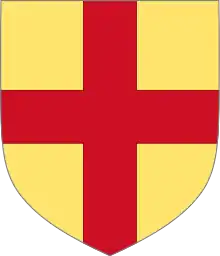William Donn de Burgh, 3rd Earl of Ulster
William de Burgh, 3rd Earl of Ulster and 4th Baron of Connaught (17 September 1312 – 6 June 1333) was an aristocrat in the Peerage of Ireland. His murder at age 20 led to the Burke Civil War.
William Donn de Burgh, 3rd Earl of Ulster | |
|---|---|
 Arms of William Donn de Burgh: Or, a cross gules. | |
| Predecessor | Richard Óg de Burgh, 2nd Earl of Ulster |
| Successor | Elizabeth de Burgh, 4th Countess of Ulster |
| Born | 13 September 1312 |
| Died | 6 June 1333 (aged 20) |
| Noble family | Burke |
| Spouse(s) | Maud of Lancaster |
| Issue | |
| Parents | John de Burgh Elizabeth de Clare |
Background
The grandson of the 2nd Earl Richard Óg de Burgh via his second son, John, William de Burgh was also Lord of Connaught in Ireland, and held the manor of Clare, Suffolk.
He was summoned to Parliament from 10 December 1327 to 15 June 1328 by writs addressed to Willelmo de Burgh. In 1331 he was appointed Lieutenant of Ireland for a year.[1]
Marriage and issue
The 3rd Earl of Ulster married, before 16 November 1327 (by a Papal Dispensation dated 1 May 1327), Maud of Lancaster, daughter of Henry, 3rd Earl of Lancaster and Maud Chaworth. They had only one surviving child, Elizabeth, Countess of Ulster, who was 13 months old when he was murdered. She married Lionel of Antwerp, third son of Edward III of England.
Murder
In February 1332, at Greencastle, near the mouth of Lough Foyle, he had his cousin Sir Walter Liath de Burgh starved to death. In revenge, Sir Walter's sister, Gylle de Burgh, wife of Sir Richard de Mandeville, planned his assassination.
In June 1333, he was killed by de Mandeville, Sir John de Logan, and others. The Annals of the Four Masters noted that "William Burke, Earl of Ulster, was killed by the English of Ulster. The Englishmen who committed this deed were put to death, in divers ways, by the people of the King of England; some were hanged, others killed, and others torn asunder, in revenge of his death."
His widow, Maud, fled to England, where she remarried, was again widowed in 1346, and then became an Augustinian canoness at Campsey Priory, where she is buried. Upon his death, the various factions of the de Burghs, now called Burke, began the Burke Civil War for supremacy.
Ancestry
| Ancestors of William Donn de Burgh, 3rd Earl of Ulster | ||||||||||||||||||||||||||||||||||||||||||||||||||||||||||||||||||||||||||||||||||||||||||||||||||||||||||||||||||||||||||||||||||||||||||||||||||||||||||||||||||||||||||||||||||||||||||||||||||||||||||||||||||||||||||||||||||||||||||||||||||||||||||||||||||||||||||||||||||||||||||||||||||||||||||||||||||||||||||||||||||||||||||||||||||||||||||||||||||||||||||||||||||||||||||||||||||||||||||||||||||||||||||||||||||||||||||||||||||||||||||||||||||||||||||||||||||||||||||||||||||||||||||||||||||||||||||||||||||||||||||||||||||||||||||||||||||||||||||||||||||||||||||||||||||||||||||||||||
|---|---|---|---|---|---|---|---|---|---|---|---|---|---|---|---|---|---|---|---|---|---|---|---|---|---|---|---|---|---|---|---|---|---|---|---|---|---|---|---|---|---|---|---|---|---|---|---|---|---|---|---|---|---|---|---|---|---|---|---|---|---|---|---|---|---|---|---|---|---|---|---|---|---|---|---|---|---|---|---|---|---|---|---|---|---|---|---|---|---|---|---|---|---|---|---|---|---|---|---|---|---|---|---|---|---|---|---|---|---|---|---|---|---|---|---|---|---|---|---|---|---|---|---|---|---|---|---|---|---|---|---|---|---|---|---|---|---|---|---|---|---|---|---|---|---|---|---|---|---|---|---|---|---|---|---|---|---|---|---|---|---|---|---|---|---|---|---|---|---|---|---|---|---|---|---|---|---|---|---|---|---|---|---|---|---|---|---|---|---|---|---|---|---|---|---|---|---|---|---|---|---|---|---|---|---|---|---|---|---|---|---|---|---|---|---|---|---|---|---|---|---|---|---|---|---|---|---|---|---|---|---|---|---|---|---|---|---|---|---|---|---|---|---|---|---|---|---|---|---|---|---|---|---|---|---|---|---|---|---|---|---|---|---|---|---|---|---|---|---|---|---|---|---|---|---|---|---|---|---|---|---|---|---|---|---|---|---|---|---|---|---|---|---|---|---|---|---|---|---|---|---|---|---|---|---|---|---|---|---|---|---|---|---|---|---|---|---|---|---|---|---|---|---|---|---|---|---|---|---|---|---|---|---|---|---|---|---|---|---|---|---|---|---|---|---|---|---|---|---|---|---|---|---|---|---|---|---|---|---|---|---|---|---|---|---|---|---|---|---|---|---|---|---|---|---|---|---|---|---|---|---|---|---|---|---|---|---|---|---|---|---|---|---|---|---|---|---|---|---|---|---|---|---|---|---|---|---|---|---|---|---|---|---|---|---|---|---|---|---|---|---|---|---|---|---|---|---|---|---|---|---|---|---|---|---|---|---|---|---|---|---|---|---|---|---|---|---|---|---|---|---|---|---|---|---|---|---|---|---|---|---|---|---|---|---|---|---|---|---|---|---|---|---|---|---|---|---|---|---|---|---|---|---|---|---|---|---|---|---|---|---|---|---|---|---|---|---|---|---|---|---|---|---|---|---|---|---|---|---|---|---|---|---|---|---|---|---|---|---|---|---|---|---|---|---|---|---|---|---|---|---|---|---|---|---|---|---|---|---|---|---|---|---|---|---|---|---|---|---|---|---|---|---|---|---|---|---|---|---|---|---|---|---|---|---|---|---|---|---|---|---|---|---|---|---|---|---|---|---|---|---|---|---|---|---|---|---|---|---|---|---|---|
| ||||||||||||||||||||||||||||||||||||||||||||||||||||||||||||||||||||||||||||||||||||||||||||||||||||||||||||||||||||||||||||||||||||||||||||||||||||||||||||||||||||||||||||||||||||||||||||||||||||||||||||||||||||||||||||||||||||||||||||||||||||||||||||||||||||||||||||||||||||||||||||||||||||||||||||||||||||||||||||||||||||||||||||||||||||||||||||||||||||||||||||||||||||||||||||||||||||||||||||||||||||||||||||||||||||||||||||||||||||||||||||||||||||||||||||||||||||||||||||||||||||||||||||||||||||||||||||||||||||||||||||||||||||||||||||||||||||||||||||||||||||||||||||||||||||||||||||||||
References
- O'Mahony, Charles (1912). The Viceroys of Ireland. p. 16.
- Archer, Thomas Andrew (1886). . In Stephen, Leslie (ed.). Dictionary of National Biography. 7. London: Smith, Elder & Co.
- Ancestral Roots of Certain American Colonists Who Came to America Before 1700 by Frederick Lewis Weis; Lines 73–30, 177B-8, 177B-9.
- The Tribes and customs of Hy-Many, John O'Donovan, 1843
- The Surnames of Ireland, Edward MacLysaght, Dublin, 1978.
- The Anglo-Normans in Co. Galway: the process of colonization, Patrick Holland, Journal of the Galway Archaeological and Historical Society, vol. 41,(1987–88)
- Excavation on the line of the medieval town defences of Loughrea, Co. Galway, J.G.A.& H.S., vol. 41, (1987–88)
- Anglo-Norman Galway; rectangular earthworks and moated sites, Patrick Holland, J.G.A. & H.S., vol. 46 (1993)
- Rindown Castle: a royal fortress in Co. Roscommon, Sheelagh Harbison, J.G.A. & H.S., vol. 47 (1995)
- The Anglo-Norman landscape in County Galway; land-holdings, castles and settlements, Patrick Holland, J.G.A.& H.S., vol. 49 (1997)
- Annals of Ulster at CELT: Corpus of Electronic Texts at University College Cork
- Annals of Tigernach at CELT: Corpus of Electronic Texts at University College Cork
- Revised edition of McCarthy's synchronisms at Trinity College Dublin.
| Peerage of Ireland | ||
|---|---|---|
| Preceded by Richard Óg de Burgh |
Earl of Ulster 1326–1333 |
Succeeded by Elizabeth de Burgh |